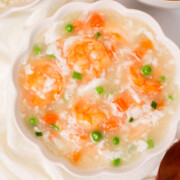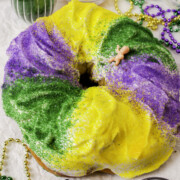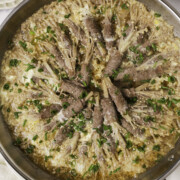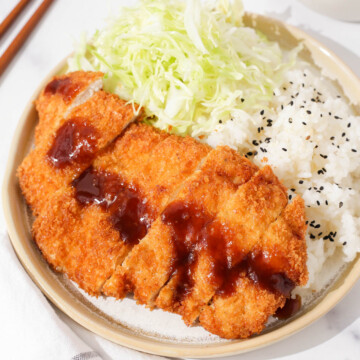Hollandaise, a classic sauce made of egg yolks, butter, some acidic and seasonings, can upgrade your weekend brunch at home from mundane to posh! Here are 3 ways to make a classic hollandaise: traditional (by hand), with a blender (or hand blender), or with a siphon canister.
Hollandaise is one of the five mother sauces we learned in culinary school during our foundation courses. It's our favorite brunch sauce and probably yours too. So we thought it would be cool and interesting (because we're food nerds 😆) to show you guys 3 ways to make hollandaise! You're welcome. 😉
If you're looking for other sauces and condiments, you may like the following:
- Easy Blackberry Compote
- Traditional Napa Cabbage Kimchi
- Instant Pot Yogurt
- Homemade Creme Fraiche
- Buttery Caramel Sauce
Let's dive into some tips and FAQs for making hollandaise, 3 ways!
What does hollandaise taste like?
A properly made hollandaise sauce should taste creamy, rich, and buttery. It should also have a good balance of acid and seasoning including, but not limited to, salt, paprika, cayenne, hot sauce, etc. The texture should be velvety and smooth, similar to cream sauce consistency. And depending on the method you make your hollandaise with, it could result in a fluffier and lighter hollandaise.
Must I use butter?
To use butter or not, that is the real question, haha. In our opinion, butter is necessary because unfortunately, this sauce's foundation is based on butter. No plant-based butter nor oil can replace the flavor butter gives to food. So, in this case, hollandaise probably will never be on a vegan menu.
On the topic of butter, we do recommend using decent quality butter because butter is majority of this sauce. And as my preference for using unsalted butter for desserts and baking, same goes to savory. Unsalted butter gives you more control over your seasoning (the amount of salt) that'll be going into whatever your making, plus, it's much more versatile.
Should I use lemon juice or vinegar?
Both acids are fine to use, but we prefer the flavor of lemon juice because vinegar is more pungent than what we like. So feel free to substitute the lemon juice for other vinegars. I do recommend using a little less vinegar than lemon juice to start and adjust it to your taste as needed.
Can I make hollandaise ahead of time?
Yes, you can make your hollandaise 1 to 2 days ahead of time. Just make sure to cover the sauce with the plastic wrap touching the surface to prevent a skin from forming and store it in the fridge.
When you need it, gently warm it up in a water bath or a bowl of hot water at 150F and give the sauce a good whisk or blending.
How to fix a broken hollandaise:
Broken sauces are one of the kitchen's number one nemesis. For hollandaise, the reason why it breaks is usually either because the butter wasn't emulsified properly or the hollandaise overheated. If you catch your hollandaise breaking early enough, there's still hope!
To fix a just broken hollandaise, first take the bowl off of the heat. Then, whisk in either a couple teaspoons of hot water or an additional egg yolk and continue whisking vigorously while drizzling in small amounts of butter at a time. I recommend switching to a hand blender if possible for a higher chance of saving your hollandaise. If the butter still does not emulsify with the egg yolk, chances are, you have to start over.
What can I serve with hollandaise?
Hollandaise is popular and amazing with most savory brunch items. Because of it's velvety, smooth texture and balanced citrusy butteriness, hollandaise is a perfect match for light seafoods like salmon, mussels, white fish, etc. And with hollandaise, of course we can't forget about classic eggs benedict and asparagus! They're oldies but will always be goodies. As for Kyong, he loves a good hollandaise with steak and potato.
3 Methods of Making Hollandaise:

Method #1: Traditional Hollandaise - use a bain-marie & whisking by hand
This method of making hollandaise is the most traditional and requires only common items in your kitchen. All you need is a heatproof bowl, a medium saucepan, a whisk, and an optional kitchen towel (I recommend).
- In a heatproof bowl, add your egg yolks, acid, and seasoning (if desired). Whisk everything together and place the bowl over the saucepan of simmering water.
- While whisking, slowly drizzle in melted butter, a little at a time, until all of the butter is added and the hollandaise is one emulsified sauce. If the hollandaise look too thick, whisk in a small amount of water, 1 teaspoon at a time, until it reaches desired consistency. Remove from heat.
- Adjust and finish seasoning the hollandaise with salt, paprika, cayenne, hot sauce, and other seasonings if preferred.
Use a heatproof bowl that fits over your saucepan.
Make sure to use a heat proof bowl that sits comfortably inside of the saucepan when you're making hollandaise via the bain-marie method. This is especially essential for those of you that have gas stove range because the fire spilling up the sides can cook your egg yolks in an instant. So be wary of bowl overhang!
Damp kitchen towel to the rescue!
Another trick we learned in culinary school is to wrap the rim of your saucepan with a damp kitchen towel so that the metal rim of the saucepan (which conducts more heat) won't scramble your egg yolks. This tip is especially relevant if you can't find a bowl that doesn't overhang your saucepan.
Use your hands as a temperature gauge.
One of my most trusted guidelines when making hollandaise the traditional way is using my hands to determine if the heat is too high. While whisking your hollandaise over your saucepan of simmering water, hold the side of the bowl with your hand. If, at any time, the bowl feels hotter than comfortable to hold, you should remove the bowl from the saucepan. Keep whisking the hollandaise on the side until the bowl has cooled down before replacing it over the simmering water.
Method #2: Blender Hollandaise
This method of making hollandaise breaks the tradition, but it is definitely the fastest way to get hollandaise ready for brunch. All you need is a trusty blender with a center cap, a food processor, or hand blender, aka immersion blender. Our favorite is the hand blender.
- Heat up the butter until melted and hot. DON'T brown it (unless it's intentional for brown butter)! Just until hot!
- Meanwhile, add your egg yolks and acid to your blender or food processor. You can pre-season with salt and spices if you prefer.
- When the butter is melted and hot, start the blender on low speed with the lid on but the center cap off. Slowly drizzle the hot butter into the blender until all the butter is used up and the hollandaise is emulsified and thick. If needed, add a small amount of water to the hollandaise, one teaspoon at a time, until desired consistency is reached.
- Adjust and finish seasoning the hollandaise to your preference with salt, paprika, cayenne, hot sauce, etc.
For hand blenders:
If you want to use a hand blender, the process is very similar to the blender process. I highly recommend finding a heatproof cylindrical container (that fits your hand blender of course). We usually use our tumbler.
Combine the egg yolks and acid to your container. While blending on low speed, slowly drizzle in hot butter until all is used up. Keep blending on low speed until the hollandaise is emulsified. If the the sauce is too thick, add small amounts of water to adjust the consistency. Season the hollandaise to your preference.
Make sure the butter is HOT.
Unlike the traditional method, the only heat that's cooking the egg yolk is the butter. So make sure the butter is hot (but not browned) when drizzling it into your egg yolk mixture.
Method #3: Siphon/ Whipping Canister
The last method is less common and more of a modern practice in gastronomy. This method requires a siphon canister, also known as a whipping canister, food safe iSi nitrogen chargers, and a sieve. Although using a siphon to make hollandaise may seem a little over the top, it is a savior for brunch catering events that features hollandaise because you can make it ahead of time and it'll maintain its quality.
- Whisk together egg yolks, the acid, and seasonings.
- While whisking, slowly pour in hot butter until all is used and everything is just combined.
- Strain the sauce base with a sieve into the siphon canister, then charge the canister with 1 nitrogen cartridge. Following the nitrogen charge, vigorously shake the canister about 16 times.
- Keep the canister in 150F water bath for at least 30 minutes to 1 hour, or until needed, to gently heat up the hollandaise.
Is straining necessary?
Yes. For any siphon canister recipes, it is super crucial to strain the liquid to prevent solids from clogging up the canister's dispenser. We always recommend it. It is better to be safe than sorry.
Use only one charge of nitrogen cartridge.
We recommend only charging the canister with only 1 charge of nitrogen cartridge even if you fill the canister up to the max line. Overcharging your canister will result in extra thick hollandaise, and that is not what you want. Your hollandaise should dispense like velvety cool whip then melts into a perfect sauce. If you find your hollandaise too loose when you dispense it, you could charge it with another cartridge, but we never had that issue.
Do I have to keep the canister in a water bath?
We highly recommend keeping the canister in a 150F water bath for at least 30 minutes to 1 hour after charging it with nitrogen. Even though the egg yolk is technically cooked when you added hot butter, the nitrogen charged into the canister cooled the hollandaise when it was aerated. So keeping the canister in the water bath will not only reheat the hollandaise, it will ensure that the egg is cooked.
Make this ahead of time.
For this method, you can make the hollandaise base (egg yolks, acid, seasoning, and butter included) ahead of time. Keep the base chilled. When you need it, simply heat it up by placing it in a 150F water bath for 1 hour. When it's hot, transfer it to the siphon canister and give it a nitrogen charge and you're good to go. Just remember to keep it in the 150F water bath when you're not using it.
Cook with love!
Mei ❤️
If you’ve made this recipe or any recipe from our blog, please tag us on Instagram @twoplaidparons! We would love to see your creations! It absolutely makes our day! 🥰
📖 Recipe
How to Make Hollandaise: 3 Ways
Ingredients
- 3 large egg yolks
- 12 Tablespoon unsalted butter, melted and hot (or 1½ stick)
- 1½ Tablespoon lemon juice (or to your preference)
- Pinch of salt (or to taste)
- Pinch of cayenne (or to taste)
- Pinch of paprika (or to taste)
- Dash of hot sauce (to taste; optional)
- Water (as needed)
Instructions
Method #1: Traditional/ Bain Marie
- In a heatproof bowl, beat together egg yolks, lemon juice, salt, paprika, and cayenne. Place the bowl over a saucepan of simmering water and constantly whisk the egg mixture to prevent the egg from scrambling.While whisking, slowly drizzle hot butter into the egg yolk mixture until all the butter is used. If needed, pause in between small additions of butter and remove the bowl from heat if the sides of the bowl gets hotter than comfortable to hold.Once all the butter is added, remove the hollandaise sauce from the heat. If the sauce is too thick for your liking, whisk in some water, about 1 teaspoon at a time, until it's your desired thickness. Adjust the seasoning with more salt, cayenne, and hot sauce to taste.
Method #2: Food Processor, Blender, or Hand (Immersion) Blender
- *If using hand blender, use a tall container.*Add egg yolks, lemon juice, and seasonings to the blender or food processor. While blending on low speed, stream hot butter slowly into the the blender and blend the mixture until it's pale, fluffy, and thick.Adjust the thickness of the hollandaise with a small amount of water if necessary (start with 1 teaspoon). Season the hollandaise with more salt, paprika, cayenne, and hot sauce as needed.
Method #3: Siphon/ Whipping Canister
- Whisk together the egg yolks and lemon juice. While whisking, stream hot butter slowly into the egg yolks just to combine everything. Season hollandaise with salt, paprika, cayenne, and hot sauce to your preference. Strain the sauce through a sieve into the siphon canister. Charge the canister with one iSi nitrogen cartridge then shake it vigorously for about 16 times.Keep the canister in 150°F water bath until needed.































Comments
No Comments